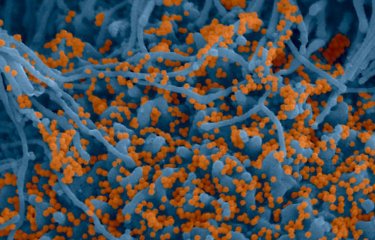-
Article | 2020.06.16
Development of simple Covid-19 serological tools and targeted serosurvey of at-risk individuals
Aim: to develop simple serological tools that can be used to establish three tests: an enzyme-linked immunosorbent assay (ELISA), an immunofluorescence assay (IFA) and multiplex microsphere-based immunoassays (MIAs – capable of detecting several targets). This research will pave the way for the serological investigation of at-risk individuals such as those working at animal markets, farmers...
-
Article | 2020.06.16
Spike glycoprotein, lentiviral vectors and B/T-cell vaccine
Aims: to develop as quickly as possible:an in vitro test to detect and quantify SARS-CoV-2 neutralizing antibodies while avoiding the need to handle the virus. The test will be used to demonstrate the feasibility of vaccine candidates (proof of concept).The availability of a test of this type is crucial in searching for antibodies in samples from patients with Covid-19. These...
-
Article | 2020.06.16
Production of recombinant antigens from two SARS-CoV-2 proteins and generation of nano-antibodies against these proteins for diagnostic and therapeutic applications
Aim: to develop reliable rapid diagnostic tests for the infection that can be performed in a few minutes, anywhere and at any time, outside research laboratories; and serological tests to monitor the spread of the outbreak virtually in real time, helping with the implementation of mitigation measures.The idea is to generate the following unique tools as quickly as possible:recombinant SARS-...
-
Article | 2020.06.16
Monitoring the origins and transmission/spread of SARS-CoV-2 in Laos and Vietnam: searching for SARS-like viruses and detecting antibodies in vertebrates
Collaborative project between the Institut Pasteur in Paris, the Institut Pasteur du Laos and the National Institute of Hygiene and Epidemiology in Vietnam.Aims: - to search for other SARS-like coronaviruses in various vertebrates and arthropods.A metagenomic analysis will be carried out using next-generation sequencing (NGS) technologies on selected samples.- to detect past coronavirus...
-
Article | 2020.06.16
Isolating and characterizing the human antibodies that neutralize SARS-CoV-2
Aim: to elucidate the mechanisms behind the antibody responses to SARS-CoV-2 and investigate the role they may play in eliminating the virus in infected individuals. The idea is to improve our understanding of the antibody responses of anti-SARS-CoV-2 memory B lymphocytes at molecular and functional level (B lymphocytes are the immune cells that produce antibodies). The memory B cells that...
-
Article | 2020.06.16
Characterization of interaction between SARS-CoV-2 Nsp3 protein and non-canonical nucleic acid structures (G4) present in infected cells
Aim: to characterize the molecular interaction of the SARS-CoV-2 virus, and particularly two domains of its Nsp3 protein, with non-canonical nucleic acid structures present in human cells. These structures known as G4-RNA and their interaction with Nsp3 constitute new therapeutic targets. Tests developed under this project will enable research on molecules to inhibit such host-virus...
-
Article | 2020.06.16
A combination of cutting-edge proteomic approaches for improving understanding of SARS-CoV-2 infection mechanisms
Aim: to characterize the cellular mechanisms of SARS-CoV-2 infection. Using several cutting-edge mass spectrometry protein analysis techniques, the team is seeking to understand how the virus interacts with human cells. They are particularly interested in cellular mechanisms that enable the virus to modify proteins in infected cells in order to reproduce. This study conducted in tandem with...
-
Article | 2020.06.16
Red Cross health workers and volunteers and continuity of care with COVID-19: an operational approach using mixed methods
Aim: to study social and cultural challenges encountered by French Red Cross health workers and volunteers (who work with healthcare facilities/hospitals, nursing homes, etc. as well as those working in the field to assist migrants, homeless people, and frail and elderly people) and monitor communication in mainstream and social media to adapt the response to the pandemic in each region. By...
-
Article | 2020.06.16
Generation of animal models sensitive to SARS-CoV-2 to test vaccines or drugs
Aim: Rapid development of animal models is of utmost importance to test the efficacy of vaccines and drug against COVID-19. The aim of this research project is to propose models whose cells express the human ACE2 proteins (huACE2) so that they are sensitive to SARS-CoV-2. The ACE2 protein is the gateway for the virus to enter cells. Researchers are proposing to use adenoviruses and...
-
Article | 2020.06.16
Randomized trial of Covid-19 chemoprophylaxis in healthcare professionals
Objective: To determine whether a two months treatment with hydroxychloroquine (HCQ) or Lopinavir / ritonavir (LPV / r) reduces the incidence of symptomatic or asymptomatic infections with SARS-CoV-2, compared to their placebo, in healthcare professionals exposed to the virus.In the absence of specific antiviral treatment, particular attention must be paid to prevention. Individual protective...


